Have you ever tried to take better care of your teeth, only to wince the moment you floss? You’re not alone. Many people notice their gums hurt when flossing, and it can make you wonder if you’re doing something wrong or if something more serious is going on. It’s frustrating when something that’s supposed to keep your mouth healthy ends up causing pain instead.
In this post, we’ll break down the real reasons your gums hurt when flossing and what you can do to fix it. You’ll learn when it’s normal, when to worry, and the best ways to soothe your gums and prevent that stinging pain in the future. By the end, you’ll know exactly how to floss without the hurt.
Why Is Flossing So Important?
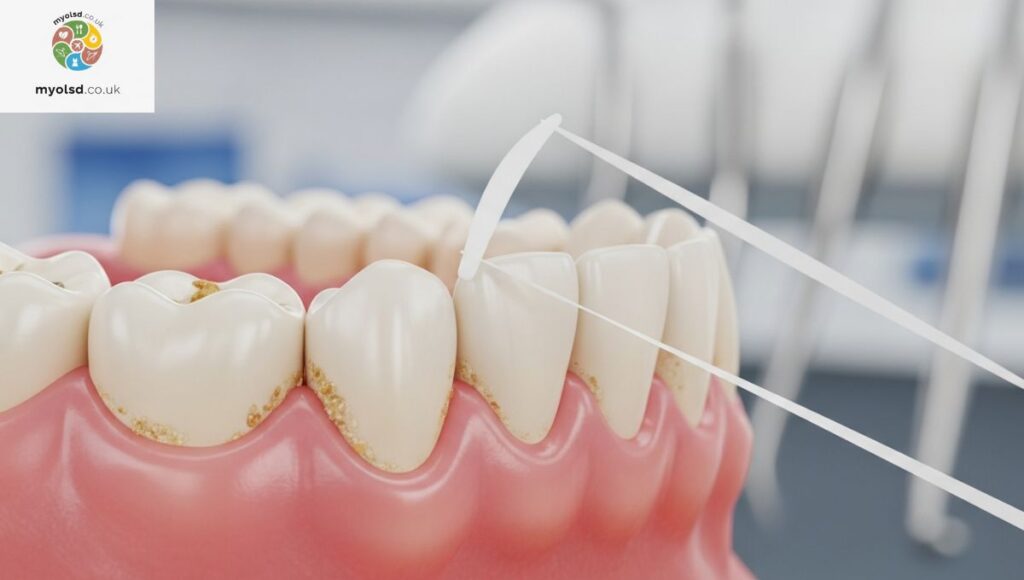
Flossing is a key part of oral hygiene that removes plaque and food particles from between teeth areas your toothbrush can’t reach. When done regularly, it prevents gum disease, tooth decay, and tartar buildup, keeping your smile healthy and your breath fresh.
However, despite its importance, many people don’t floss as often as they should. This neglect allows plaque bacteria to build up, harden into tartar, and inflame your gum tissue, leading to gingivitis or even periodontitis in severe cases. Flossing helps keep your gum health in check and protects the foundation of your teeth.
1. Not Flossing Enough
If you rarely floss and suddenly start doing it again, your gums may feel sore. That’s because your gum tissue isn’t used to the contact, and plaque bacteria sitting between your teeth can irritate the area. With consistent flossing, this soreness usually fades within a few days as your gums become healthier.
2. Improper Flossing Technique
Flossing too aggressively or snapping the floss into your gums can cause pain and even bleeding. The goal is to gently curve the floss along each tooth, sliding it under the gum line in a C-shape. Using a sawing motion or forcing the floss between tight spaces can damage gum tissue, making your gums hurt when flossing.
3. Flossing with the Wrong Devices
Not all flossing tools are created equal. If your teeth are tightly spaced, standard floss might be uncomfortable. Try waxed floss, floss picks, or a water flosser these can reduce friction and make cleaning easier. People with braces, dental bridges, or implants often find that interdental brushes or super floss are more effective and comfortable.
4. Gum Disease and Tooth Decay
When gums are inflamed or infected, even gentle flossing can cause discomfort. Conditions like gingivitis or periodontitis make the tissue sensitive to pressure and touch. If your pain persists despite gentle technique, visit a dental professional for a full evaluation. You may have underlying tooth decay or infection that needs attention.
5. Sensitive Teeth
Tooth sensitivity often comes from enamel wear or gum recession, exposing the dentin layer underneath. This area contains nerve endings that react to cold, touch, or pressure. Using desensitizing toothpaste and avoiding overly cold or hot foods can help ease discomfort while you maintain your flossing routine.
Read more Article: Knocking Pipes When Water Isn’t Running?
Is It Normal for My Teeth to Hurt After Flossing?
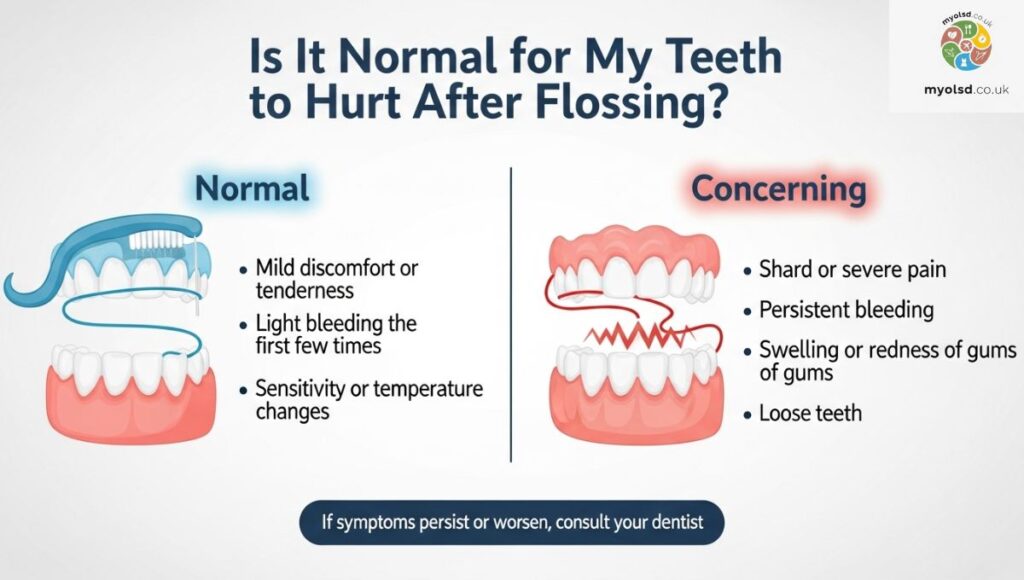
It’s normal for gums to feel tender when you start flossing again after a break, or when you’re new to the habit. However, ongoing pain, swelling, or bleeding shouldn’t be ignored. Persistent pain might mean your gums are inflamed or you’re using the wrong flossing technique.
Let’s explore what might be causing your pain after flossing and how to fix it.
6 Common Causes of Pain When Flossing
Gum Disease or Gum Recession
Early gum disease (gingivitis) can cause your gums to bleed and feel sore when touched. If untreated, it can lead to gum recession, where tissue pulls away from the tooth, exposing roots. This makes flossing painful and teeth more sensitive.
Improper Flossing Technique
Flossing should be gentle and controlled, never harsh or rushed. Avoid snapping the floss or digging too deeply under the gumline. The correct way is to slide it carefully between teeth, curve it, and move it up and down a few times to remove debris.
Tight Spaces Between Teeth
If your teeth are very close together, floss can catch or shred. Try waxed floss or dental tape designed for tight spaces. A water flosser or interdental brush can also make cleaning easier without pain.
Cavities
Cavities between teeth can expose sensitive areas. When floss touches these spots, it can cause sharp pain. Regular dental checkups and x-rays help identify hidden decay before it worsens.
Dental Work and Appliances
If you have braces, crowns, or bridges, flossing can sometimes tug or irritate your gums. Tools like floss threaders or super floss make it easier to maneuver around dental work without discomfort.
Underlying Dental Health Issues
Conditions like tooth infections, abscesses, or bone loss from periodontal disease can make flossing painful. If the pain is localized to one area or gets worse, see your dentist as soon as possible.
Flossing Techniques and Their Impact
Flossing isn’t about brute force; it’s about precision and consistency. The right method not only keeps your gums healthy but also prevents irritation and inflammation.
Here’s how to make flossing more comfortable and effective.
4 Tips for Pain-Free Flossing
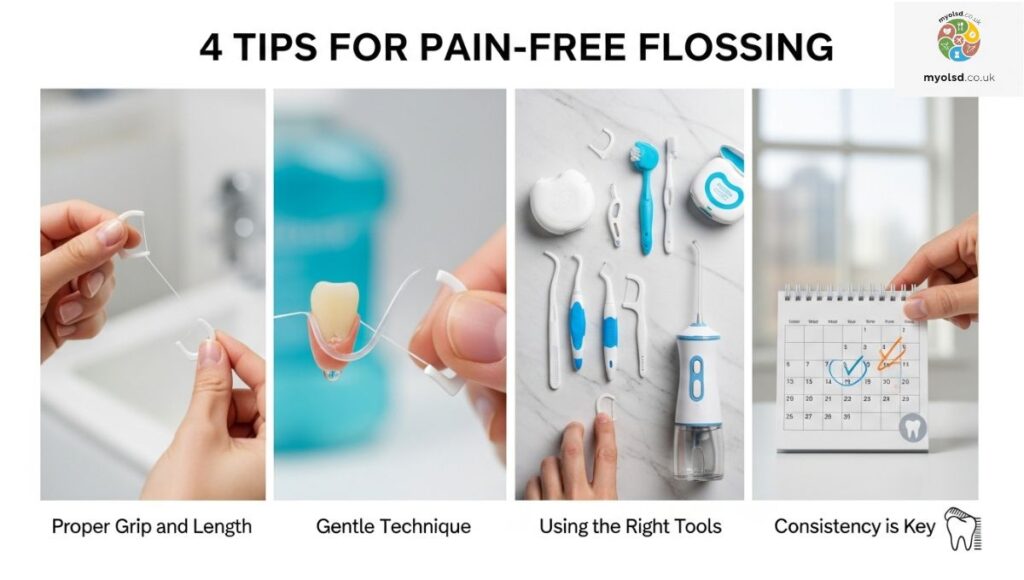
1. Use the Right Floss
Choose waxed floss, dental tape, or floss picks based on your tooth spacing and sensitivity. For sensitive gums, try soft thread floss or water flossers that use gentle streams of water to clean between teeth.
2. Perfect Your Technique
Gently slide the floss down between two teeth, curve it into a C shape, and move it up and down along the side of each tooth. Avoid snapping or pulling harshly; that’s a common cause of pain and gum injury.
3. Be Consistent but Gentle
Flossing once a day helps your gums adapt and reduces inflammation. Inconsistent flossing causes plaque buildup, making your gums tender every time you start again.
4. Consider Alternatives Like Water Flossers
Water flossers are ideal for people with braces, dental implants, or gum sensitivity. They remove food particles and plaque using pulsating water, improving oral hygiene without causing pain.
When Should I See a Dentist About Flossing Pain?
If your gums stay sore for more than a week or you notice bleeding that doesn’t stop, visit a dentist. Persistent pain could indicate early gum disease, gingivitis, or another underlying condition. Your dentist can recommend a cleaning, fluoride treatment, or a desensitizing agent to strengthen enamel and reduce sensitivity.
Causes of Bleeding Gums
Bleeding gums are often the first sign that something’s wrong. While mild bleeding can occur when you start flossing again, it shouldn’t last long. If it does, it may point to plaque buildup, gum inflammation, or vitamin C deficiency.
Common causes include:
- Improper flossing or brushing too hard
- Hormonal changes during pregnancy or menopause
- Smoking or poor nutrition
- Autoimmune conditions that weaken gum tissue
Bleeding Gums Remedies
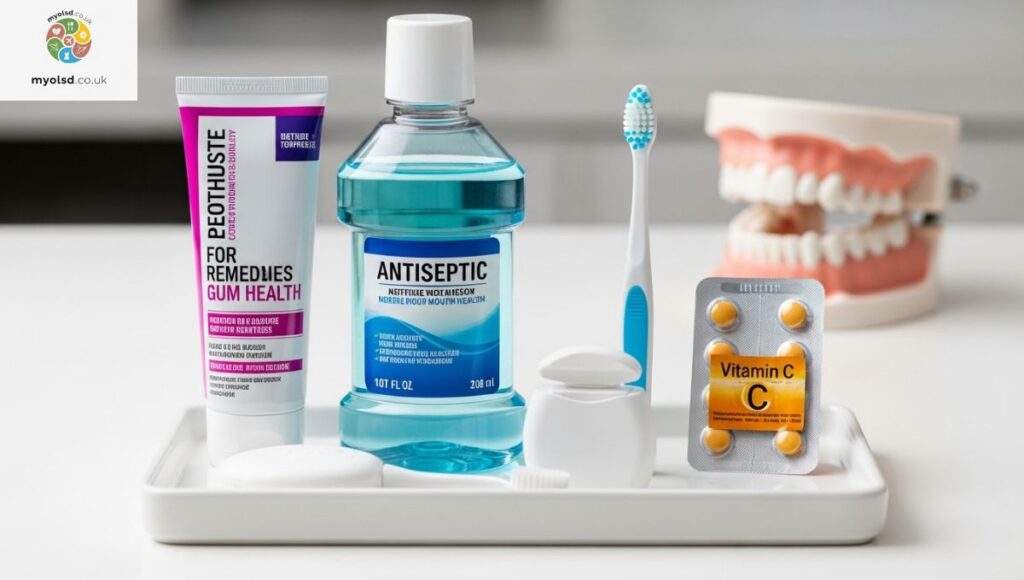
- Rinse with salt water or an antiseptic mouthwash to kill bacteria
- Apply clove oil or turmeric paste for natural anti-inflammatory relief
- Use a soft-bristled toothbrush and avoid harsh scrubbing
- Eat foods rich in vitamin C and calcium to strengthen gum tissue
- Switch to desensitizing toothpaste if gums feel sore or tender
Dental Checkups and Your Gums
Even with a perfect home care routine, you can’t remove all tartar or bacteria at home. Regular professional cleanings remove buildup from under the gumline and prevent serious conditions like periodontitis. Aim for dental visits every 6 months or more often if your dentist recommends it.
What’s Behind Your Smile?
Healthy gums don’t just make your teeth look better; they’re the foundation of a strong smile. Redness, swelling, or tenderness are signs that your mouth needs attention. Addressing pain early prevents more serious problems later.
Why Do My Gums Hurt?
When your gums hurt when flossing, it’s your body’s way of telling you something needs care. It could be inflammation, improper technique, or an early stage of gum disease. Don’t ignore it. Gentle, consistent care will heal your gums over time.
Home Remedies for Gum Pain
Try these gentle at-home treatments:
- Salt water rinse twice daily to reduce swelling
- Honey or turmeric paste to soothe inflammation
- Cold compress for soreness or puffiness
- Hydrogen peroxide rinse (diluted) for disinfecting
- Avoid alcohol-based mouthwashes, which can dry and irritate gums
How to Treat Gum Pain
Use desensitizing toothpaste, avoid acidic foods, and floss gently every day. If pain continues, see a dental hygienist for a deep cleaning or scaling.
How to Treat Sore Gums
Sore gums often respond well to rest, hydration, and switching to a soft-bristle brush. Avoid hard or crunchy foods until the tenderness subsides.
Read more Article: Knocking Pipes When Water Isn’t Running?
How to Treat Gum Infections
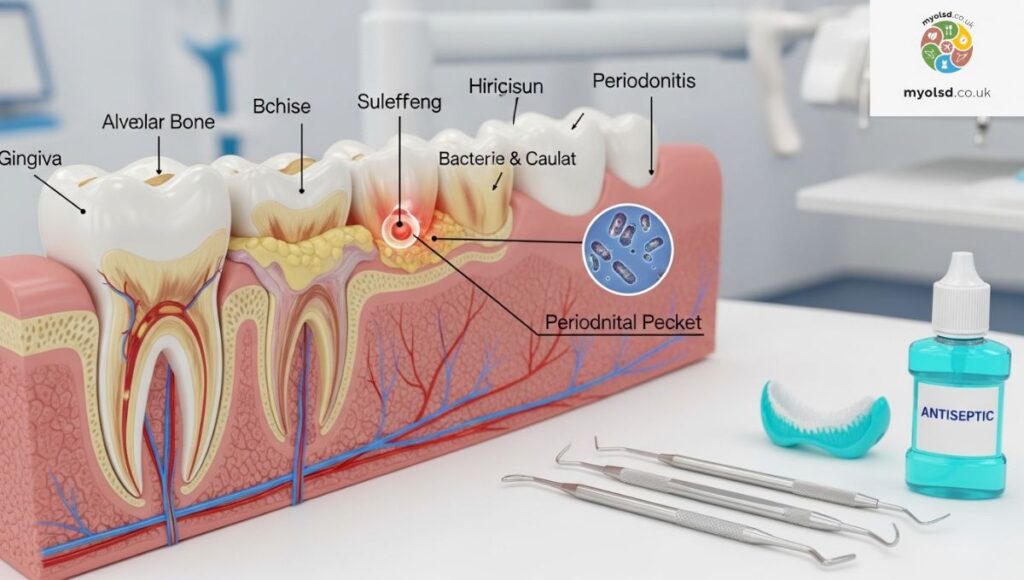
If your pain worsens, you may have a gum infection or abscess. Seek prompt care from a periodontal specialist. They may prescribe antibiotics or perform a cleaning called scaling and root planing to remove bacteria beneath the surface.
When to See the Dentist
You should see a dentist if you experience:
- Gum bleeding that lasts longer than a week
- Persistent bad breath
- Loose teeth or gum recession
- Sharp pain or swelling near one tooth
- Signs of infection, like pus or throbbing pain
Final Thoughts
If your gums hurt when flossing, it’s not always a sign of serious trouble, but it’s never something to ignore. Often, it’s your gums adjusting to a new routine or responding to inflammation caused by plaque. With the right technique, gentle care, and regular dental visits, your gums will become stronger, healthier, and pain-free.
Flossing shouldn’t hurt; it should heal. Keep at it consistently, and your smile will thank you.
FAQs
1. Gums hurt when flossing, but no bleeding
If your gums hurt when flossing but don’t bleed, it’s usually due to sensitivity or using too much pressure. Try gentler flossing and switch to a soft, waxed floss or a water flosser to reduce irritation.
2. One tooth hurts when I floss
Pain around one tooth often means trapped food, a cavity, or early gum inflammation. Focus on cleaning gently around that tooth and visit your dentist if the pain continues for more than a few days.
3. Throbbing gum pain after flossing
Throbbing gum pain may indicate infection, gum injury, or inflammation beneath the surface. Rinse with warm salt water and see a dentist if the pain doesn’t ease within 24 to 48 hours.
4. How to relieve gum pain from flossing
Use salt water rinses, desensitizing toothpaste, or a soft-bristled toothbrush to calm sore gums. Staying consistent with gentle flossing helps your gums strengthen and heal over time.
5. Why does it hurt when I floss between two teeth
Pain between two teeth can happen if plaque buildup, tight spacing, or enamel wear irritates. Use waxed floss and avoid snapping the floss into your gums to prevent further pain.
6. Gums hurt when flossing Reddit
Many Reddit users report gum pain when starting to floss regularly. It’s often a sign of mild inflammation that improves with consistent, gentle flossing and better oral hygiene.
7. Gums hurt when flossing, but no bleeding reddit
Discussions on Reddit suggest that gum pain without bleeding may come from flossing too hard or sensitive gum tissue. Switching to a water flosser or softer floss usually helps.
8. Nerve pain when flossing teeth
Sharp or shooting pain during flossing may be related to exposed dentin or nerve irritation from gum recession. Use desensitizing products and avoid aggressive flossing until your dentist checks the area.

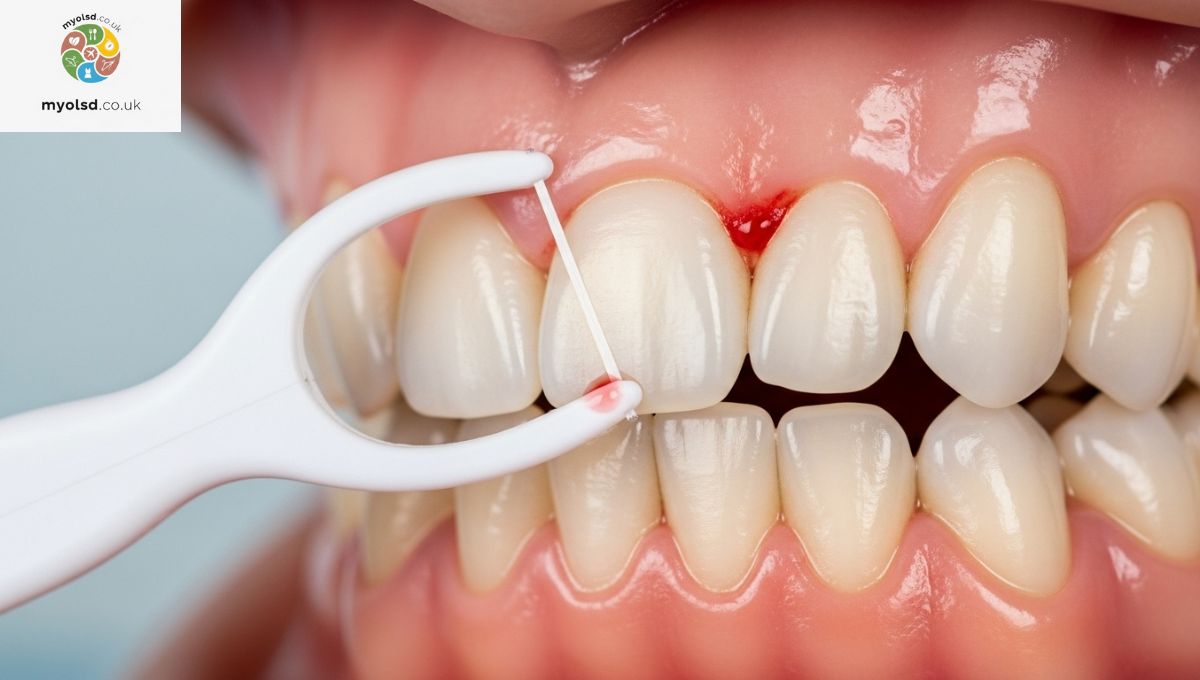
85i3f4